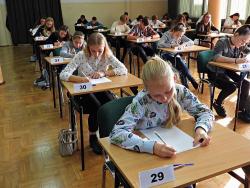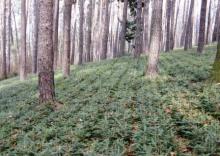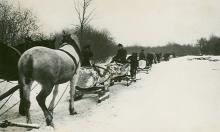 Asset Publisher
Asset Publisher
Polish forests
Poland is in the European lead, while concerning the area of all forests. They cover about 29,2 % of the country territory, and grow within the area of 9,1 million hectares. The overwhelming majority of the forests is state owned, of which almost 7,6 million hectares are managed by the State Forests National Forest Holding..
The number of Polish forest is still growing. The forestation rate of the country has increased from 21 % in 1945 to 29,2 % at the moment. Between 1995 and 2008, the forest area increased by 310 thousand ha. The basis for afforestation works is the "National Programme for Increasing the Forest Cover" (KPZL), assuming an increase of the forestation rate up to 30 % by 2020 and up to 33 % by 2050. Polish forests abound in flora, fauna and fungi. 65 % of the total number of animal species live there.
The forests grow in our country on poor soils, mainly because of the development of the agriculture in previous years. It influences the distribution of the types of the forest sites in Poland. Over 55 % of the forest areas is covered with coniferous forests. In other areas, there are forest sites, mainly the mixed ones. Their small part constitute alder and riparian forests – not more than 3 %.
In the years 1945 – 2011 the area of natural deciduous tree stands within the area of the State Forests National Forest Holding increased from 13 to 28,2 %.
Within the lowlands and uplands the most often occurring tee species is pine. It covers 64,3 % of the forest area of the State Forests National Forest Holding and 57,7 % of private and commune forests. In the mountains the predominant species is European spruce ( in the west) and European spruce with beech (in the east). Domination of pine is the result of carrying on sustainable forest management in the past. Once, the monocultures (crops or cultivations of one species) were the answer to the great demand of industry for wood. Such forests appeared to be quite fragile to climatic factors. They also were often the prey of pests' expansion.
In Polish forests, the share of other tree species, especially deciduous trees have been systematically increasing. The foresters have stepped aside from monocultures – that is why, they try to fit specific species of the forest stand to the natural stand, that would be proper for the given area. Thanks to that, in the years 1945 – 2011, the area of the deciduous tree stands within the lands of the State Forests National Forest Holding increased from 13 to 28,2 %. There occur more and more frequently the following tree species: oaks, ashes, maples, sycamore maples, elms, but also birches, beeches, alders, poplars, hornbeams, aspens, tilias and willows.
Our forests are the most often represented by the forest stands aged 40 to 80 years. The average age of the forest equals 60 years. More and more trees are of big size at the age over 80 years. Since the end of the Second World War, the forests' area has increased up to almost 1,85 million hectares.
Raport o stanie lasów w Polsce 2012
 Asset Publisher
Asset Publisher
Las oniryczny czyli...LEŚNE DYKTANDO
Las oniryczny czyli...LEŚNE DYKTANDO
 fot. Wojciech Hamerla Zespół Szkół Zawodowych w Dynowie
fot. Wojciech Hamerla Zespół Szkół Zawodowych w Dynowie
 Fot. Wojciech Hamerla Zespół Szkół Zawodowych w Dynowie
Fot. Wojciech Hamerla Zespół Szkół Zawodowych w Dynowie
 Fot. Wojciech Hamerla Zespół Szkół Zawodowych w Dynowie
Fot. Wojciech Hamerla Zespół Szkół Zawodowych w Dynowie
 Fot. Wojciech Hamerla Zespół Szkół Zawodowych w Dynowie
Fot. Wojciech Hamerla Zespół Szkół Zawodowych w Dynowie
IX edycja Leśnego Dyktanda przeszła już do historii. W konkursie, który odbył się 30 października 2019 roku wzięło udział 57 osób z 15 szkół. Dzieci i młodzież – tak jak co roku – miały za zadanie napisać dyktando wymyślone przez dynowskich leśników. I tak jak co roku spisały się fantastycznie. Jak policzyliśmy, w dyktandzie można było popełnić co najmniej 90 błędów ortograficznych! Uczniowie jednak stanęli na wysokości zadania, albowiem zwycięzca Leśnego Dyktanda, Kamil Szymański z Liceum Ogólnokształcącego w Dynowie, popełnił tylko trzy błędy! Natomiast zwycięzca w kategorii szkoły podstawowe, Seweryn Chrapek ze Szkoły Podstawowej w Dąbrówce Starzeńskiej popełnił ich zaledwie pięć.
Uczestnicy konkursu mieli okazję sprawdzić swoje umiejętności nie tylko w dyktandzie. Podczas oczekiwania na wyniki konkursu uczestniczyli bowiem w pokazie chemicznym, przygotowanym przez pracowników naukowych oraz studentów Wyższej Szkoły Wschodnioeuropejskiej w Przemyślu. Chyba najlepszym słowem opisującym pokaz jest: spektakularny. Dzieci przekonały się, że chemia to nie tylko zapisy wzorów i pierwiastków w zeszytach.
Dziękujemy wszystkim uczniom i uczennicom biorącym udział w konkursie – mamy nadzieję, że była to dla Was ciekawa przygoda i wartościowe doświadczenie. Dziękujemy opiekunom uczniów- którzy zawsze bardzo wnikliwie, starannie i sprawnie sprawdzają prace konkursowe. Wysoka frekwencja w konkursie świadczy o tym, że dzieciom i młodzieży droga jest zarówno przyroda, jak i nasz, wcale nie łatwy, język ojczysty. Bardzo nas to cieszy.
Organizatorami IX edycji Leśnego Dyktanda byli: Nadleśnictwo Dynów, Zespół Szkół Zawodowych w Dynowie oraz Stowarzyszenie Zespołu Szkół Zawodowych w Dynowie. Stałym partnerem konkursu jest również Miejska Biblioteka Publiczna w Dynowie.
Patronat honorowy nad konkursem objęli: Dyrektor Regionalnej Dyrekcji Lasów Państwowych w Krośnie Grażyna Zagrobelna, Starosta Powiatu Rzeszowskiego Józef Jodłowski, Burmistrz Miasta Dynów Zygmunt Frańczak. Patronat medialny nad wydarzeniem objęło Polskie Radio Rzeszów S.A oraz Portal Regionalny „Brzozowiana”.


 fot. Paweł Fabijański
fot. Paweł Fabijański
 fot. Paweł Fabijański
fot. Paweł Fabijański
 fot. Paweł Fabijański
fot. Paweł Fabijański





